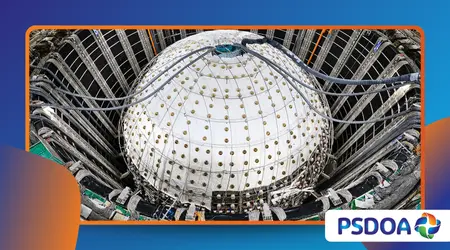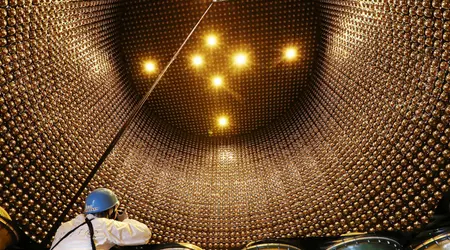Neutrino Observatories: Listening to the Universe’s Ghost Particles

Neutrino Observatories represent humanity’s most profound effort to eavesdrop on the universe through the medium of ‘ghost particles.’
Anúncios
These subatomic phantoms, called neutrinos, are truly massless (or possess incredibly tiny mass), travel nearly at the speed of light, and interact so rarely with matter that trillions pass through our bodies every second, undetected.
Building vast, specialized Neutrino Observatories deep underground, underwater, or under the Antarctic ice is the only way scientists can patiently await the infinitesimal chance of a fleeting interaction.
This new, non-electromagnetic astronomy is opening a revolutionary “fourth window” onto the cosmos, revealing sources and events that are entirely opaque to traditional light-based telescopes.
While photons are easily absorbed by dense matter like stellar cores or thick dust clouds, neutrinos stream through unimpeded, carrying pristine information directly from the universe’s most violent and hidden corners.
Anúncios
Consequently, they are essential for solving the largest mysteries of the cosmos, from the origins of high-energy cosmic rays to the unknown nature of matter.
What Are Ghost Particles and Why Are They So Hard to Catch?
Why Do Neutrinos Earn the Nickname “Ghost Particles”?
Neutrinos have earned their ethereal moniker because they possess no electric charge and interact only via the weak nuclear force and gravity.
This makes their interaction cross-section incredibly small, allowing them to pass through light-years of solid lead as easily as a bullet travels through air.
This extreme elusiveness is both their defining characteristic and the primary challenge for particle physicists worldwide.
To overcome this, scientists must construct detectors of immense scale and place them in environments shielded from background noise, such as the natural radioactivity of the Earth or the constant shower of cosmic rays.
The sheer volume of the detection medium be it ultra-pure water, heavy water, or ice maximizes the odds of catching even a single, rare neutrino event.
++ The Mystery of Sonoluminescence: When Sound Creates Light
What Fundamental Physics Questions Can Neutrinos Help Answer?
These elusive particles hold the keys to fundamental questions about the Standard Model of particle physics and the origins of matter itself.
The confirmed phenomenon of neutrino oscillation where they change or “oscillate” between three “flavors” (electron, muon, and tau) proved they must have mass, defying the original theory.
This discovery has spurred the construction of next-generation facilities like the Deep Underground Neutrino Experiment (DUNE) to determine the exact ordering of these tiny masses (the mass hierarchy).
Furthermore, studying the oscillation difference between neutrinos and their antimatter counterparts (antineutrinos) could reveal why the universe is predominantly made of matter, one of cosmology’s greatest puzzles.

Where Are the World’s Major Neutrino Observatories Located?
Why Must Neutrino Observatories Be Built Deep Underground or Underwater?
The primary challenge in detecting a neutrino is filtering out the noise from every other particle hitting the Earth, particularly muons generated by cosmic rays in the atmosphere.
These unwanted particles are numerous and mimic the signal scientists are searching for.
The solution is strategic placement: burying the detectors deep beneath a mountain (like Super-Kamiokande in Japan) or submerging them kilometers deep in ice or water (like IceCube and KM3NeT).
The surrounding rock, water, or ice acts as a massive, natural shield, absorbing all known background radiation and particles, allowing the sensitive detectors to register only the few rare neutrino interactions that penetrate.
Also read: The Bizarre Physics of Time Crystals
What are the Key Differences Between IceCube and the KM3NeT Arrays?
The world’s largest high-energy Neutrino Observatories utilize natural bodies as their detection medium.
The IceCube observatory transforms a cubic kilometer of clear Antarctic ice into a vast, three-dimensional array of sensors, making it the world’s largest neutrino telescope.
In contrast, KM3NeT (Cubic Kilometre Neutrino Telescope) is a multi-site deep-sea observatory currently under construction in the Mediterranean Sea.
KM3NeT, with its ARCA (Astroparticle Research with Cosmics in the Abyss) and ORCA (Oscillation Research with Cosmics in the Abyss) components, aims to perform high-energy astrophysics and study the fundamental properties of neutrinos, respectively, showcasing the international race to master neutrino detection.
| Neutrino Observatory | Location (2025 Status) | Primary Detection Medium | Main Physics Goal |
| IceCube | South Pole, Antarctica | Antarctic Ice | Ultra-high-energy Cosmic Neutrinos |
| KM3NeT (ARCA) | Mediterranean Sea | Deep Seawater | High-Energy Astrophysical Sources |
| JUNO | Jiangmen, China (Operational Aug 2025) | Liquid Scintillator | Neutrino Mass Hierarchy & Oscillation |
| Super-Kamiokande | Kamioka, Japan | Ultra-Pure Water | Solar, Atmospheric, and Supernova Neutrinos |
How Do Neutrino Observatories Actually Work?
What Is Cherenkov Light and Why Is It Essential for Detection?
The fundamental principle behind most large Neutrino Observatories is the detection of Cherenkov radiation.
While the neutrino itself leaves no trace, its extremely rare interaction with an atom (in water or ice) can produce a high-speed, charged secondary particle, typically a muon or an electron.
If this secondary particle travels through the detection medium faster than the speed of light in that medium (which is slower than the speed of light in a vacuum), it creates a sonic boom-like wave of blue light.
This flash of Cherenkov light is captured by thousands of highly sensitive Photomultiplier Tubes (PMTs) embedded throughout the detector volume, allowing scientists to reconstruct the neutrino’s original path and energy.
Read more: Rare asteroid impact fragments in Australia
What Was the Groundbreaking Discovery Regarding the Galactic Plane?
A major recent highlight, building on years of IceCube data, was the first neutrino-based view of our own Milky Way galaxy.
In 2023, scientists confirmed the detection of a significant flux of high-energy neutrinos originating from the galactic plane itself.
This confirmed the Milky Way is a source of cosmic accelerators, something long suspected but never directly observed through this particular particle channel.
It marks a historic moment, as it completes the cosmic picture provided by gamma-rays and cosmic rays, solidifying the role of Neutrino Observatories in mapping the extreme physics of our immediate cosmic neighborhood.
Why Are Neutrinos Key to Multi-Messenger Astronomy?
What Is Multi-Messenger Astronomy and Why Are Neutrinos Crucial to It?
Multi-messenger astronomy is a revolutionary approach that combines observations from different “messengers” from the universe electromagnetic waves (light), gravitational waves, cosmic rays, and neutrinos to study a single cosmic event.
By combining signals, scientists gain a far more complete and dynamic picture of the event’s underlying physics.
Neutrinos are uniquely critical because they are the only messenger guaranteed to escape the densest, most energetic sources like merging black holes, core-collapse supernovae, and active galactic nuclei (AGN) jets.
Their non-interaction means they arrive instantly and directly, unlike light, which can be trapped or delayed, providing an instantaneous alert to massive cosmic cataclysms.
Pinpointing an Astrophysical Jet
In 2017, the IceCube Neutrino Observatories provided a key element in the first multi-messenger observation of a blazar (a type of AGN) known as TXS 0506+056.
A high-energy neutrino arrived at IceCube, prompting a massive global follow-up campaign by electromagnetic telescopes across the spectrum.
This coordinated effort identified the blazar as the likely source, linking the elusive neutrino to a specific, supermassive black hole jet over four billion light-years away.
This event provided the first direct evidence of where ultra-high-energy cosmic rays are born, demonstrating the detective work only neutrino astronomy can perform.
The JUNO Detector’s New Mission
The Jiangmen Underground Neutrino Observatory (JUNO), officially commencing data collection in August 2025, represents a significant step forward.
JUNO is the world’s first ultra-large, ultra-precision experiment dedicated to determining the neutrino mass ordering.
Located 700 meters underground in China, its core feature is a massive 20,000-ton spherical detector filled with liquid scintillator.
By observing antineutrinos from distant nuclear power plants, JUNO is expected to achieve an unprecedented precision (less than 3% uncertainty) on key oscillation parameters, reshaping the Standard Model of particle physics.
Conclusion: The Quiet Revolution in Astro-Science
The rise of Neutrino Observatories marks a quiet yet profound revolution in science. These colossal, often hidden, instruments are patiently decoding the universe’s most subtle signals, transforming elusive “ghost particles” into powerful messengers.
From solving the cosmic mystery of matter dominance to locating the most energetic accelerators in the far reaches of space, their discoveries fundamentally reshape our understanding of physics.
The work is slow, laborious, and requires infrastructure on an unimaginable scale, but the rewards are priceless a true, unadulterated glimpse into the universe’s most extreme mechanisms.
The current era of multi-messenger astronomy, powered by these specialized detectors, is setting the stage for paradigm-shifting revelations throughout the remainder of the decade.
The question is no longer if these observatories will revolutionize science, but what universe-altering secrets they will reveal next.
Frequently Asked Questions (FAQ)
What are Neutrinos, and why are they called “Ghost Particles”?
Neutrinos are fundamental subatomic particles with virtually no mass and no electric charge.
They are nicknamed “ghost particles” because they rarely interact with matter, allowing trillions of them to pass through solid objects, including the Earth, without being detected.
What is the main purpose of Neutrino Observatories?
The main purpose is to detect the rare interactions of high-energy neutrinos.
This allows scientists to use them as cosmic messengers to study distant, violent astrophysical events (like supernovae and blazars) and to investigate the fundamental properties of the neutrino itself, such as its mass hierarchy.
How do scientists actually detect something that rarely interacts?
Scientists use massive detectors (often cubic kilometers in volume) placed in extremely deep, dark, and isolated locations (underground, underwater, or under ice).
These detectors are filled with ultra-pure materials and lined with thousands of light sensors (PMTs) to capture the faint Cherenkov light produced when a neutrino rarely hits an atom, creating a charged particle.
What is the most famous discovery made by a neutrino observatory?
One of the most significant recent discoveries was the first confirmed link between a high-energy neutrino detected by IceCube and a specific cosmic source, the blazar TXS 0506+056 in 2017.
This marked a monumental step forward for multi-messenger astronomy.
What is the current “real-time” news about a major neutrino observatory (2025)?
In August 2025, the Jiangmen Underground Neutrino Observatory (JUNO) in China successfully completed its massive detector filling and commenced formal data collection.
JUNO is now the largest and most precise experiment dedicated to solving the neutrino mass ordering, one of the biggest outstanding puzzles in particle physics.
